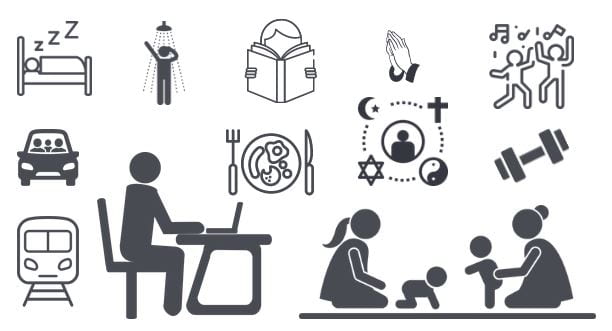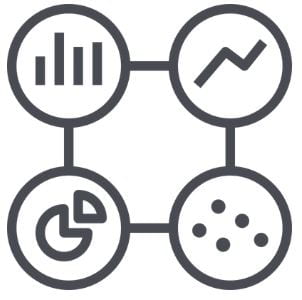THRUST 4
Modeling adaptable
Human Behavior
Thrust 4 focuses on developing a model of disease spreading dynamics and behavior diffusion as well as enhanced activity choice models to replicate real-world choices and behaviors in response to external conditions during disruptions.
THRUST 4 focus
Behavioral Choices During Disruptions
Development of enhanced choice models of activity-travel demand will reflect how individuals motivated by perceived risk adapt to new operational modalities during disruptions.
Physical-Virtual Accessibility Measures
Focuses on the sensitivity of accessibility measures to operational modalities of human activities, transportation modes, and businesses, in both physical and virtual worlds will inform our models.
Disease Spreading Dynamics
Development of a comprehensive behaviorally sensitive model of the disease spread dynamics will also reflect social diffusion effects and information propagation using real-world data.
Background
HUMAN BEHAVIORS AND CHOICES IN THE WAKE OF DISRUPTIONS
- Activity/time use patterns shape an individual’s sense of well-being.
- Disruptions limit people’s ability to maintain their daily activity/travel routines.
- During a disruption, individuals adapt their activity type, schedule, duration, location, and modality to sustain their pre-disruption activity and travel patterns.

Behaviors and choices evolve over time as conditions change and vice versa.
WHO ARE THE LEAST/MOST ADAPTABLE GROUPS?
Our goal is to assess the determinants of individual activity patterns during a disruption and develop adaptability metrics to identify the population groups who are most affected/least adaptable.
Determinants of Individual Activity Patterns
- Disruption-related attributes: Severity, Restricted activities and choice sets…
- Socio-demographics /economic attributes: Age, Gender, Income, Education…
- Attitudes, perceptions, and lifestyles: Risk perception, Technology savviness, Variety-seeking lifestyle…
- Mobility/built environment/ accessibility attributes: Travel mode, Population density, Virtual and physical accessibility measures…
Adaptability Metrics
Indicators of well-being will be used to measure adaptability.
- Subjective well-being scores: We are developing a well-being estimator that translates activity/time use patterns of individuals into a well-being score.
- Time poverty: Having relatively less time to engage in discretionary activities.
- Zero-trip making: A situation in which individuals make no trips in a day, potentially leaving them at risk of social exclusion.
OUR DEVELOPED MODELS AND METRICS CAN BE USED TO
- Identify (least-adaptable) risk-prone groups in society during disruption Devise appropriate policies to address equity issues arising from a disruption
- Test scenarios and evaluate the impacts of potential policies and strategies
- Estimate demand for transit and businesses (focused on restaurants/grocery stores)

Ongoing Research Activities
Well-being Implications of COVID-19: This study investigates the changes in activity-travel and time use patterns during the COVID-19 pandemic and their impacts on individual well-being. Using data from the American Time Use Survey (ATUS) for the years 2019 and 2020, the study employs two well-being assessment methods (a well-being scoring method and a time poverty analysis method) to evaluate the impacts of these changes on societal well-being, with a particular focus on identifying vulnerable and less adaptable groups. The research findings are presented in a paper titled “An Analysis of Changes in Time Use and Activity Participation in Response to the COVID-2019 Pandemic in the United States: Implications for Well-being“, which can be accessed at this link.
Food Access Vulnerability During COVID-19: Using a comprehensive behavioral survey dataset collected during the peak of the COVID-19 pandemic in 2020, this study aims to identify vulnerable and less adaptable groups in terms of food access during the pandemic. The study considered two food types (groceries and meals) and three access modes (in-person, online with in-person pickup, and online with delivery) to analyze food access modalities at the individual level. The findings reveal that minorities, low-income individuals, and individuals residing in rural low-density areas are particularly vulnerable to experiencing food access challenges. The research results are presented in a paper titled “Access to Food in a Severe Prolonged Disruption: The Case of Grocery and Meal Shopping During the COVID-19 Pandemic“, which is available at this link.
An Open-Source Well-being Analysis Tool: The research team is developing an open-source activity/time use-based tool to analyze the impact of changes in activity and time use patterns on the well-being of various population groups on a year-to-year basis. The tool, called TOMNET Wellbeing Platform, utilizes data from the American Time Use Survey (ATUS) and consists of three activity/time use-based wellbeing indicators – a subjective wellbeing indicator called WBEAT, a time poverty indicator, and a zero trip-making indicator. The platform can help identify racial, economic, and other social disparities in society, and provide insights into potentially vulnerable groups during disruptions. The beta version of the tool is available at this link.
TEAM MEMBERS
Thrust 4 is based in the School of Sustainable Engineering and the Built Environment at Arizona State University
CONTACT us
Please reach out if you are interested in learning more about our research.